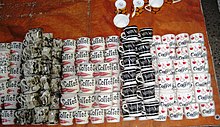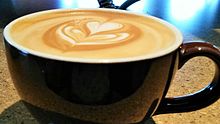Coffee cup
Coffee cups and mugs may be made of glazed ceramic,[1] porcelain, plastic, glass, insulated or uninsulated metal, and other materials.
These cups were tall due to the habit of drinking the liquid layer at the top, with the preparation sediment left at the bottom.
[3]: 232 By the early 18th century, the European taste for handles on cups, strongly evident from antiquity, reasserted itself and a single vertical handle was added to a slightly more upright Chinese-style bowl to create both the very similar forms of the Western teacup and coffee cup, as well as a saucer.
European porcelain manufacturers encouraged the development of different sizes of cup, and shapes of pot, for tea and coffee services.
[dubious – discuss] These cups are made of porcelain and shaped to encourage and aid in creating latte art.
The data can also be applied to societal uses of fluid systems on Earth, such as improving the design of portable medical blood testers for infectious diseases.
A famous design of a paper coffee cup is the Anthora, which has become symbolic of New York City's daily life.
The German consumer group Stiftung Warentest raised concerns that these substances constitute a health hazard when used for hot drinks.
The UK Food Standards Agency advised retailers in June 2023 to withdraw bamboo cups, making further sales unlawful.
[18] In 1986, the Solo Traveler lid was created; it is found in the Museum of Modern Art's 2004 exhibit "Humble Masterpieces".
[22] Polystyrene foam cups have the reputation of not being recyclable,[23] non-biodegradable,[23][24] a major part of marine litter,[25] and has various health risks.
It is banned as a food and drink container in several U.S. cities including Portland, Ore., San Francisco, Calif., and Amherst, Mass.
[34] Use of reusable cups declined sharply to reduce the chance of infection with the onset of the covid pandemic in 2020, and as of 2023 had not returned to previous levels.






